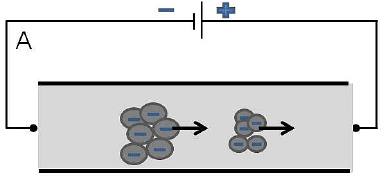Definition of Electrophoresis in Microfluidics
This technology leverages the principles of electrophoresis, a technique used to separate charged particles under an electric field, and microfluidics, the science of manipulating and controlling fluids at the microscale.
Electrophoresis microfluidics is a specialized branch of microfluidics focused on the manipulation and analysis of biological particles, including DNA, RNA, proteins, and cells, within microfluidic channels.
Electrophoresis microfluidics has revolutionized the field of bioanalysis by enabling high-throughput, automated, and miniaturized assays. As a result, it has become integral to fields such as genomics, proteomics, cell biology, clinical diagnostics, and drug discovery.
Principles of Electrophoresis
Electrophoresis is a technique used to separate charged particles in a fluid by applying an electric field. Particles migrate towards the electrode with the opposite charge at speeds proportional to their charge-to-mass ratios. The separation of particles occurs due to differences in their mobility, influenced by particle size, shape, and charge.
Electrophoresis can be performed in a free solution or within a matrix such as a gel, which serves as a molecular sieve, that slows down larger particles more than smaller ones; this results in a separation based on size as well as charge. The separated particles can be visualized using various detection methods, such as staining, fluorescence, or radioactivity.
Types of Electrophoresis
There are several types of electrophoresis, each with its own advantages and applications.
- Capillary electrophoresis (CE) involves the separation of particles in a thin capillary tube filled with an electrolyte. It offers high resolution, speed, and sensitivity, making it suitable for the analysis of complex mixtures.
- Agarose gel electrophoresis is commonly used for the separation of DNA and RNA fragments. The gel acts as a molecular sieve, slowing down larger fragments more than smaller ones.
- Polyacrylamide gel electrophoresis (PAGE) is used for the separation of proteins and small nucleic acids. It offers a higher resolution than agarose gel electrophoresis but requires more careful handling due to the toxicity of acrylamide.
Integration of Electrophoresis and Microfluidics
The synergy between electrophoresis and microfluidics combines the separation capabilities of electrophoresis with the precise, automated, and high-throughput fluid control offered by microfluidics.
In electrophoresis microfluidics, an electric field is applied across a microfluidic channel, driving the movement and separation of charged particles based on their mobility. These particles can be detected using various methods and collected for further analysis. This integration has led to the development of miniaturized, automated, and high-throughput electrophoretic assays.
Microchip Electrophoresis
Microchip electrophoresis is a form of electrophoresis microfluidics conducted on a microfabricated chip with a network of microchannels. This technique offers several advantages over traditional electrophoresis, including faster separation times, reduced sample and reagent consumption, and the potential for integration with other microfluidic functions.
It has been employed to separate a wide range of particles, from small ions to large biomolecules and cells. Applications of microchip electrophoresis include DNA sequencing and genotyping in genomics, protein separation and identification in proteomics, and cell sorting and analysis in cell biology.

Applications of Electrophoresis Microfluidics
Electrophoresis microfluidics has found wide-ranging applications in the life sciences and biomedical engineering. It has been used in genomics for DNA sequencing and genotyping, in proteomics for protein separation and identification, and in cell biology for cell sorting and analysis.
Electrophoresis microfluidics has also been used in clinical diagnostics for point-of-care testing. It can perform a wide range of tests, from genetic testing to infectious disease detection, using small volumes of sample and reagent.
Genomics
Electrophoresis microfluidics has revolutionized DNA sequencing, genotyping, and mutation detection by enabling high-throughput, automated, and miniaturized assays. Microchip electrophoresis, in particular, has been used for the separation of DNA fragments, enabling high-resolution and high-speed analysis.
Electrophoresis microfluidics has also been applied to RNA analysis, facilitating studies on gene expression and RNA viruses, which are particularly valuable in cancer research.
Proteomics
Electrophoresis microfluidics aids in the separation and identification of proteins based on their size and charge, enabling the study of protein structure and function.
It has also been used for the analysis of post-translational modifications, like phosphorylation and glycosylation. These modifications, which alter protein charge and mobility, provide insights into cellular processes and disease states.
Cell Biology
In cell biology, the technology enables the separation and analysis of cells based on size and charge, aiding in the study of cell morphology, function, and surface markers. This capability is crucial for detecting specific cell types, such as cancer, stem, and immune cells.
Future Directions in Electrophoresis Microfluidics
The field of electrophoresis microfluidics is rapidly advancing, with ongoing research focused on integrating this technology with other microfluidic functions to create multifunctional lab-on-a-chip devices. These devices could combine separation, mixing, pumping, and detection on a single chip, reducing time, cost, and complexity.
Another promising area of development is the creation of portable and disposable electrophoresis microfluidic devices for point-of-care testing. These devices could be deployed in resource-limited settings or for personalized medicine, where rapid and accurate diagnostics are essential. Although challenges remain, such as fabricating low-cost, robust devices and integrating power and detection systems, progress in this area is expected to lead to significant advancements in the field.
Conclusion
Electrophoresis microfluidics is a transformative technology in bioanalysis, offering high-throughput, automated, and miniaturized assays with applications across genomics, proteomics, cell biology, clinical diagnostics, and drug discovery. While challenges such as integrating different materials and technologies and controlling fluid flow and electric fields persist, ongoing research is expected to overcome these hurdles, allowing for new techniques and applications.
